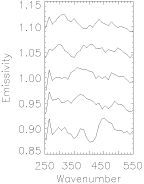
The author(s) of this abstract have provided an email address for comments about the abstract: francesca.altieri@ifsi.rm.cnr.it
[Previous] | [Session 36] | [Next]
F. Altieri, G. Bellucci (CNR IFSI Rome Italy)
The Thermal Emission Spectrometer (TES) aboard NASA mission Mars Global Surveyor (MGS) is collecting 200 - 1600 cm-1 thermal emission spectra since September 1997. The principal purpose of TES is to determine and map the Mars surface composition. Spectral features directly ascribable to surface minerals have been identified in the 300 - 500 cm-1 spectral range. Outcrops of hematite have been localized in Sinus Meridiani, Aram Chaos and Valles Marineris [1, 2] and areas with olivine have been individuated in Nili Fossae and in other limited regions [3]. On the other hand, TES spectra show, in general, significant variance between 300 and 500 cm-1; this variance is not directly attributable to surface mineralogical components. In this study we report some examples of spectra with typical hematite and olivine bands and spectra with a different spectral contrast. The spectral masking effect of a dust layer is suggested to explain this behaviour.
Spectra characterized by hematite features have been localized also inside a crater near Baldet Crater. The MOC narrow-angle image M02-0039 acquired on the same area shows dark layers at the crater bottom. References: [1] Christensen P. R., et al., JGR, 105, 9623-9642, 2000. [2] Christensen P. R., et al., JGR, in press., 2001. [3] Hoefen T. M. and Clark R. N., LPS XXXII, 2049, 2001.
The author(s) of this abstract have provided an email address
for comments about the abstract:
francesca.altieri@ifsi.rm.cnr.it
